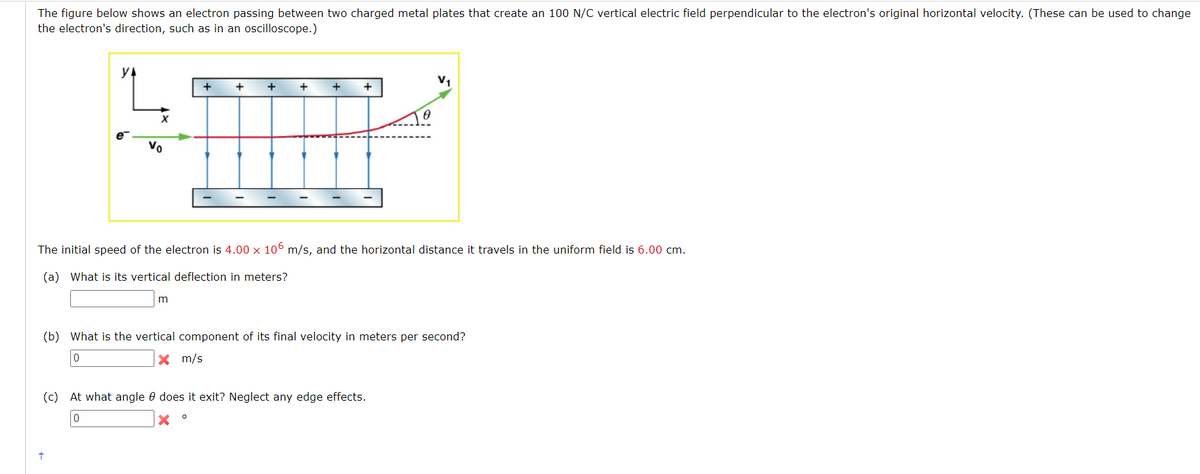The figure below shows an electron passing between two charged metal plates that create an 100 N/C vertical electric field perpendicular to the electron's original horizontal velocity. (These can be used to change the electron's direction, such as in an oscilloscope.) yA V1 + + + + Vo The initial speed of the electron is 4.00 x 106 m/s, and the horizontal distance it travels in the uniform field is 6.00 cm. (a) What its vertical deflection in meters? m (b) What is the vertical component of its final velocity in meters per second? x m/s (c) At what angle e does it exit? Neglect any edge effects.
The figure below shows an electron passing between two charged metal plates that create an 100 N/C vertical electric field perpendicular to the electron's original horizontal velocity. (These can be used to change the electron's direction, such as in an oscilloscope.) yA V1 + + + + Vo The initial speed of the electron is 4.00 x 106 m/s, and the horizontal distance it travels in the uniform field is 6.00 cm. (a) What its vertical deflection in meters? m (b) What is the vertical component of its final velocity in meters per second? x m/s (c) At what angle e does it exit? Neglect any edge effects.
Principles of Physics: A Calculus-Based Text
5th Edition
ISBN:9781133104261
Author:Raymond A. Serway, John W. Jewett
Publisher:Raymond A. Serway, John W. Jewett
Chapter19: Electric Forces And Electric Fields
Section: Chapter Questions
Problem 35P
Related questions
Question

Transcribed Image Text:The figure below shows an electron passing between two charged metal plates that create an 100 N/C vertical electric field perpendicular to the electron's original horizontal velocity. (These can be used to change
the electron's direction, such as in an oscilloscope.)
yA
V1
+
+
+
+
Vo
The initial speed of the electron is 4.00 × 106 m/s, and the horizontal distance it travels in the uniform field is 6.00 cm.
(a) What is its vertical deflection in meters?
m
(b) What is the vertical component of its final velocity in meters per second?
X m/s
(c) At what angle 0 does it exit? Neglect any edge effects.
Expert Solution
This question has been solved!
Explore an expertly crafted, step-by-step solution for a thorough understanding of key concepts.
This is a popular solution!
Trending now
This is a popular solution!
Step by step
Solved in 2 steps with 2 images

Knowledge Booster
Learn more about
Need a deep-dive on the concept behind this application? Look no further. Learn more about this topic, physics and related others by exploring similar questions and additional content below.Recommended textbooks for you

Principles of Physics: A Calculus-Based Text
Physics
ISBN:
9781133104261
Author:
Raymond A. Serway, John W. Jewett
Publisher:
Cengage Learning

Physics for Scientists and Engineers: Foundations…
Physics
ISBN:
9781133939146
Author:
Katz, Debora M.
Publisher:
Cengage Learning

College Physics
Physics
ISBN:
9781285737027
Author:
Raymond A. Serway, Chris Vuille
Publisher:
Cengage Learning

Principles of Physics: A Calculus-Based Text
Physics
ISBN:
9781133104261
Author:
Raymond A. Serway, John W. Jewett
Publisher:
Cengage Learning

Physics for Scientists and Engineers: Foundations…
Physics
ISBN:
9781133939146
Author:
Katz, Debora M.
Publisher:
Cengage Learning

College Physics
Physics
ISBN:
9781285737027
Author:
Raymond A. Serway, Chris Vuille
Publisher:
Cengage Learning

Physics for Scientists and Engineers, Technology …
Physics
ISBN:
9781305116399
Author:
Raymond A. Serway, John W. Jewett
Publisher:
Cengage Learning

College Physics
Physics
ISBN:
9781305952300
Author:
Raymond A. Serway, Chris Vuille
Publisher:
Cengage Learning